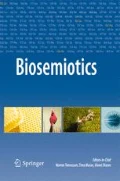Abstract
The egg behaves as a prospective cell sustaining the developmental processes of the future embryo. In biosemiotic terms, this apparent teleonomic behaviour can be accounted for without referring to the exclusive causal role played by its genetic makeup. We envision two different processes that are uniquely found in the oocyte: (1) the first involves the mechanisms by which large amounts of mRNA accumulate in the ooplasm to establish the embryo axes prior to fertilization; (2) the second involves transfer of an excess of maternally supplied ribosomes to the oocyte to provide the future embryo with newly synthesized proteins. In this paper, we argue that the information required to sustain embryonic development is not due to any physical properties of the zygotic DNA and the maternal mRNAs, but to their spatially and temporally ordered relationship in the zygote’s internal space.
Similar content being viewed by others
References
Alberts, B., Johnson, A., Lewis, J., Raff, M., Roberts, K., & Walter, P. (2002). Molecular biology of the cell (4th ed.). New York: Garland Science.
Becalska, A. N., & Gavis, E. R. (2009). Lighting up mRNA localization in Drosophila oogenesis. Development, 136, 2493–2503.
Bruni, L. E. (2011). The multitrophic plant-herbivore-parasitoid-pathogen system: A biosemiotic perspective. In K. Kull & C. Emmeche (Eds.), Towards a semiotic biology: Life is the action of signs (pp. 143–166). London: Imperial College Press.
Cariani, P. (1998). Towards an evolutionary semiotics: The emergence of new sign-functions in organisms and devices. In G. Van de Vijver, S. Salthe, & M. Delpos (Eds.), Evolutionary systems (pp. 359–377). Dordrecht: Kluwer.
Cha, B. J., Koppetsch, B. S., & Theurkauf, W. E. (2001). In vivo analysis of Drosophila bicoid mRNA localization reveals a novel microtubule-dependent axis specification pathway. Cell, 106, 35–46.
Driever, W., Siegel, V., & Nosslein-Volhard, C. (1990). Autonomous determination of anterior structures in the early Drosophila embryo by the bicoid morphogen. Development, 109, 811–820.
Favareau, D. (2010). Essential readings in biosemiotics. Anthology and commentary. New York: Springer.
Fernández, E. (2010). Taking the relational turn: biosemiotics and some new trends in biology. Biosemiotics, 3, 147–156.
Hoffmeyer, J. (2001). Life and reference. Biosystems, 60, 123–130.
Hoffmeyer, J. (2008). Semiotic scaffolding of living systems. In M. Barbieri (Ed.), Introduction to biosemiotics (pp. 149–166). Dordrecht: Springer.
Hoffmeyer, J. (2012). The semiome: From genetic to semiotic scaffolding. Semiotica (in print) [Maran, Timo (Ed.), Special issue on zoosemiotics].
Hoffmeyer, J., & Emmeche, C. (1991). Code-duality and the semiotics of nature. In M. Anderson & F. Merrell (Eds.), On semiotic modeling (pp. 117–166). Berlin and New York: Mouton de Gruyter.
Hoffmeyer, J., & Emmeche, C. (2005). Code-duality and the semiotics of nature. Journal of Biosemiotics, 1, 27–64.
Joslyn, C. (2001). The semiotics of control and modeling relations in complex systems. Biosystems, 60, 131–148.
Mothes, W., Jungnickel, B., Brunner, J., & Rapoport, T. A. (1998). Signal sequence recognition in cotranslational translocation by protein components of the endoplasmic reticulum membrane. The Journal of Cell Biology, 142, 355–364.
Nakamura, A., Amikura, R., Hanyu, K., & Kobayashi, S. (2001). Me31B silences translation of oocyte-localizing RNAs through the formation of cytoplasmic RNP complex during Drosophila oogenesis. Development, 128, 3233–3242.
Newman, S. A., & Müller, G. B. (2000). Epigenetic mechanisms of character origination. Journal of Experimental Zoology, 288, 304–317.
Niki, Y., & Mahowald, A. P. (2003). Ovarian cystocytes can repopulate the embryonic germ line and produce functional gametes. Proceedings of the National Academy of Sciences, 100, 14042–14045.
Pattee, H. H. (2001a). The physics of symbols: bridging the epistemic cut. Biosystems, 60, 5–21.
Pattee, H. H. (2001b). Irreducible and complementary semiotic forms. Semiotica, 134, 341–358.
Roth, S. (2003). The origin of dorsoventral polarity in Drosophila. Philosophical Transactions of the Royal Society, London B., 358, 1317–1329.
Roth, S., & Lynch, J. A. (2009). Symmetry breaking during Drosophila oogenesis. Cold Spring Harbor Perspective in Biology, 1, a001891.
Wang, C., & Lehmann, R. (1991). Nanos is the localized posterior determinant in Drosophila. Cell, 66, 637–647.
Wilsch-Bräuninger, M., Schwarz, H., & Nüsslein-Volhard, C. (1997). A sponge-like structure involved in the association and transport of maternal products during Drosophila oogenesis. Journal of Cell Biology, 139, 817–829.
Author information
Authors and Affiliations
Corresponding author
Rights and permissions
About this article
Cite this article
Giorgi, F., Bruni, L.E. & Goldberg, L.J. The Egg as a Semiotic Gateway to Reproduction. Biosemiotics 6, 489–496 (2013). https://doi.org/10.1007/s12304-013-9181-9
Received:
Accepted:
Published:
Issue Date:
DOI: https://doi.org/10.1007/s12304-013-9181-9




